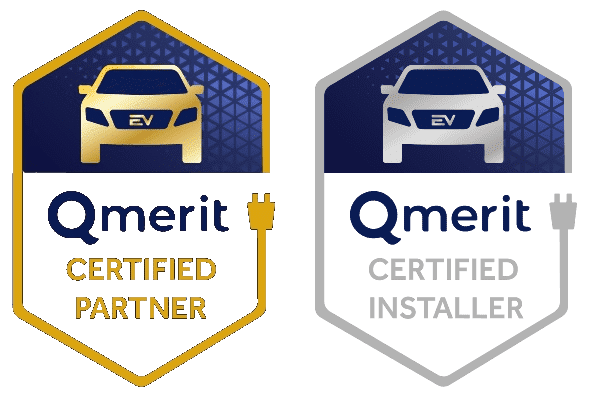Accelerate Your EV Experience with Professional Installers

Drive Green with Our Home EV Charger Setups
Upgrading your home in St. Charles or St. Louis with the best EV charging setups caters to the growing demand for EV infrastructure and significantly boosts your property value. J. Bathe Electric handles EV charging installations in St. Charles, providing services that are both efficient and aesthetically pleasing. Our EV charging stations blend seamlessly with your home’s architecture, delivering a perfect balance between functionality and style.
When necessary, our team can equip load monitoring devices to make sure that your home electrical system can support the added demand of charging an EV at home, protecting your investment. With our expertise, installing an EV home charger or even a more advanced DC fast charger becomes a hassle-free process, empowering you to lead the way in the transition to sustainable transportation.
- Enjoy the convenience of charging an EV at home, bypassing the need for public charging stations.
- Increase your home’s property value with a sought-after amenity among EV owners.
- Benefit from faster charging times with Level 2 EV chargers, making your vehicle ready when you are.
- Contribute to environmental sustainability by supporting cleaner, electric-powered transportation.
Elevate Your Property with Premier EV Charging Solutions
FAQs About EV Charger Installation
The electrical requirements for installing a home EV charger typically depend on the charger level. For Level 2 chargers, which are most common for home use, you’ll need a 240-volt electrical supply, similar to what your home uses for large appliances like dryers and ovens. The process may involve upgrading your current electrical system or adding a dedicated circuit.
Our team at J. Bathe Electric is experienced in evaluating your home’s existing electrical infrastructure and making the necessary upgrades to accommodate your new EV charger safely and efficiently.
When considering the installation of an Electric Vehicle (EV) charger at home, you have three levels to choose from: Level 1, Level 2, and DC Fast Charging.
- Level 1 Chargers are standard and often included with your vehicle. They utilize a typical household outlet, but they charge quite slowly.
- Level 2 Chargers, which offer a much faster charging speed, are the most popular choice for home installation.
- DC Fast Chargers are typically used in commercial settings due to their high power requirements.
For most homeowners, Level 2 chargers strike the ideal balance between speed, convenience, and cost, making them the go-to option for daily EV charging. Choosing the right level depends on your driving habits, budget, and electrical capacity, but Level 2 remains the most practical solution for efficient home charging.
Choosing the right location for your EV charger installation is crucial for convenience and efficiency. It should ideally be near where you park your electric vehicle and have easy access to your home’s electrical system to minimize installation complexity and cost.
Our experts at J. Bathe Electric have extensive experience assessing properties to recommend the most optimal location for your EV charger. We consider factors like cable length, charging habits, and aesthetic impact so that your charger installation is not just functional but also seamlessly integrated into your home environment.
Before installing an electric vehicle charger at home, several key factors must be evaluated to ensure safety, efficiency, and long-term compatibility with your vehicle and electrical system. Planning ahead helps avoid unexpected costs and supports smooth operation once your EV charger is in use.
Here’s what to keep in mind when preparing for a home electric vehicle charger installation:
- Vehicle Compatibility: Confirm the charger is compatible with your electric vehicle’s make, model, and onboard charging capabilities. Not every charger is a Tesla wall connector, for example.
- Charging Speed: Decide between a Level 1 charger (slower, uses standard outlets) or a Level 2 charger (faster, requires a 240V circuit).
- Electrical Capacity: Make sure your home’s electrical panel can support the added load, or plan for an upgrade.
- Installation Location: Choose a convenient, safe, and weather-protected location near where you park your vehicle.
- Permits & Codes: Before beginning installation, verify local regulations, permitting requirements, and building codes.
- Licensed Electrician: Always hire a licensed electrician to perform the work, especially if electrical upgrades are needed.
Considering these factors will help ensure your electric vehicle charger delivers reliable performance, protects your home’s electrical infrastructure, and supports future EV charging needs.
Home EV chargers are built for reliability and require minimal maintenance, but routine checks can help preserve their performance. After you install an EV charger at home, it’s a good idea to periodically inspect the charging system for wear or damage, especially the cable and plug. Keeping the unit clean and free from dust or debris ensures proper ventilation and avoids overheating.
Maintenance is especially important for homes using a Level 2 EV charger to sustain fast charging speed and safety. Make sure the charger remains securely mounted, the cable is neatly stored, and there are no signs of moisture near the wall outlet or electrical panel.
If you notice inconsistent charging or reduced miles of range per hour of charge, consult a licensed electrician to evaluate your home EV charger installation. While these systems are much more convenient than public charging stations, they may require electrical upgrades over time to stay compatible with newer electric cars and evolving technology.
Transform Your Electric Vehicle Charging Experience
Contact the professional electricians at J. Bathe Electric today to schedule your EV charger installation service. Embrace the future of driving with our expert services that promise efficiency, reliability, and unmatched convenience.
Let’s shore up your EV charging infrastructure and set the stage for a greener, more electrified tomorrow.
